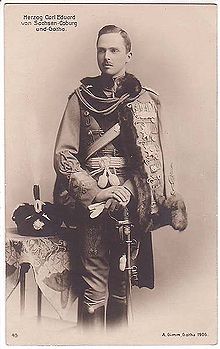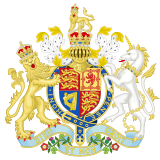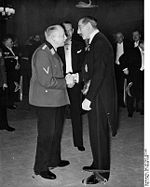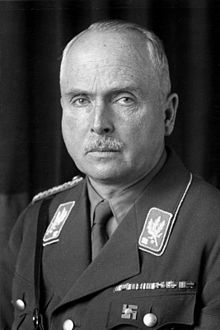- Charles Edward, Duke of Saxe-Coburg and Gotha
-
Not to be confused with Edward Charles.
Prince Charles Edward 
Duke of Saxe-Coburg and Gotha Reign 30 July 1900 – 14 November 1918 Predecessor Alfred Spouse Princess Victoria Adelaide of Schleswig-Holstein Issue Prince Johann Leopold
Princess Sibylla, Duchess of Västerbotten
Prince Hubertus
Priness Caroline Mathilde
Prince Friedrich JosiasFull name Charles Edward George Albert Leopold
German: Carl Eduard Georg Albert LuitpoldHouse House of Saxe-Coburg and Gotha Father Prince Leopold, Duke of Albany Mother Princess Helena of Waldeck and Pyrmont Born 19 July 1884
Claremont House, SurreyDied 6 March 1954 (aged 69)
Coburg, West GermanyReligion Lutheranism Charles Edward, Duke of Saxe-Coburg and Gotha (Leopold Charles Edward George Albert; German: Luitpold Carl Eduard Georg Albrecht; 19 July 1884 – 6 March 1954) was the fourth and last reigning Duke of Saxe-Coburg and Gotha, two duchies in Germany (from 30 July 1900 to 14 November 1918), and the head of the House of Saxe-Coburg and Gotha from 1900 until his death in 1954. A male-line grandson of Queen Victoria and Prince Albert, he was also a Prince of the United Kingdom and held the British title of Duke of Albany.
The Duke was a controversial figure in the United Kingdom due to his status as Sovereign Duke of Saxe-Coburg and Gotha, part of the German Empire, during World War I. He was deprived of his British peerages, his title of Prince and Royal Highness and his British honours in 1919.[1] In 1918, he was forced to abdicate his ducal throne. He also later joined the German Nazi Party, and served in a number of positions in Germany in the 1930s and 1940s, including as President of the German Red Cross.
He is the maternal grandfather of King Carl XVI Gustaf of Sweden. He was also the younger brother of HRH Princess Alice, Countess of Athlone.
Contents
Early life
Charles Edward was born at Claremont House near Esher, Surrey. His father was Prince Leopold, Duke of Albany, the fourth son of Queen Victoria and Albert, Prince Consort. His mother was the Duchess of Albany (née Princess Helena of Waldeck and Pyrmont).
As his father died before his birth, Charles Edward succeeded to his titles immediately on his birth and was styled His Royal Highness The Duke of Albany.
After becoming sick, he was privately baptised at Claremont on 4 August 1884, two weeks after his birth and later baptised publicly in Esher Parish Church on 4 December 1884 four months later. His godparents were his paternal grandmother Queen Victoria, the Prince of Wales (his paternal uncle), his paternal aunts Princess Christian of Schleswig-Holstein and the Marchioness of Lorne, Princess Frederica of Hanover (his father's second cousin), his maternal uncle Alexis, Prince of Bentheim and Steinfurt and his maternal grandfather George Victor, Prince of Waldeck and Pyrmont (neither of whom could attend).[2] His uncle, Edward VII made him a Knight of the Garter on 15 July 1902, just prior to his 19th birthday.
As a grandson of Queen Victoria, the Duke was a first cousin of King George V of the United Kingdom, Queen Maud of Norway, Grand Duke Ernest Louis of Hesse, Empress Alexandra of Russia, Queen Marie of Romania, Crown Princess Margaret of Sweden, Queen Victoria Eugenia of Spain, Queen Sophia of Greece, Queen Wilhelmina of the Netherlands, and Josias, Hereditary Prince of Waldeck and Pyrmont (the last two through his mother). The Duke was also a first cousin of the German Emperor William II, and such was the interest Wilhelm showed in his young cousin's upbringing that Carl Eduard was known as the Emperor's seventh son.[3] His mother drummed into him endlessly the importance of "becoming a good man, so you bring no shame on Papa's name".[4]
He also studied in Bonn and was a member of Corps Borussia Bonn to which he was introduced by the Emperor.
Duke of Saxe-Coburg and Gotha
In 1900, the sixteen-year-old Duke of Albany inherited the ducal throne of Saxe-Coburg and Gotha from his uncle Alfred, Duke of Saxe-Coburg and Gotha. The Duke of Edinburgh's only son, Prince Alfred ("Young Affie"), died in 1899, and the Duke of Connaught, the Queen's third son, renounced his claims to the duchy. Arthur's son, Prince Arthur of Connaught (who also renounced his claims), was attending school at Eton with Prince Charles Edward, and threatened to beat his cousin up if Charles Edward did not accept the duchy. While at school his mother would write to Charles Edward instilling in him a profound sense of duty and obligation. With such strong influences from both his mother and grandmother, the young boy had no choice but to take up the seat of Coburg in order to save that line of Royal blood.
For the next five years, he reigned under the regency of the Hereditary Prince of Hohenlohe-Langenburg, the husband of Duke Alfred's third daughter Alexandra. The regent acted under the strict guidance of the Emperor, Wilhelm II. Upon coming of age on 19 July 1905, the Duke of Saxe-Coburg and Gotha assumed full constitutional powers.
Marriage
Wilhelm picked out Charles Edward's bride for him, his niece and on 11 October 1905, at Glücksburg Castle, Holstein, the Duke married Princess Victoria Adelaide of Schleswig-Holstein (31 December 1885 – 3 October 1970), the daughter of Duke Friedrich Ferdinand of Schleswig-Holstein-Sonderburg-Glücksburg. The Duke and Duchess of Saxe-Coburg and Gotha had five children.
Through his daughter Sibylla, Charles Edward is the maternal grandfather of Carl XVI Gustav of Sweden.
World War I
World War I caused a conflict of loyalties for Charles Edward, but finally the Duke supported Germany and held a commission as a general in the German Army (although he never held a major command). Consequently, George V ordered his name removed from the register of the Knights of the Garter in 1915. In July 1917, in an effort to distance his dynasty from its German origins, George V changed the name of the British Royal House from the House of Saxe-Coburg and Gotha to the House of Windsor. That year, the British Parliament passed the Titles Deprivation Act which empowered the Privy Council to investigate "any persons enjoying any dignity or title as a peer or British prince who have, during the present war, borne arms against His Majesty or His Allies, or who have adhered to His Majesty's enemies." Under the terms of that act, an Order in Council on 28 March 1919 formally removed the Duke's British peerages, the Dukedom of Albany, Earldom of Clarence, and the Barony of Arklow. The Duke and his children also lost their entitlement to the titles of Prince and Princess of the United Kingdom and the styles Royal Highness and Highness.[5] Nevertheless, he retained the style Highness as a member of a sovereign ducal house in Germany.
Private citizen
British Royalty House of Saxe-Coburg and Gotha 
Descendants of Prince Albert Grandchildren Alfred of Edinburgh Marie of Edinburgh Victoria of Edinburgh Alexandra of Edinburgh Beatrice of Edinburgh Margaret of Connaught Arthur of Connaught Patricia of Connaught Alice of Albany Carl Eduard, Duke of Saxe-Coburg & Gotha The Russian Revolution of 1917 caused Charles much concern and he watched anxiously during the ensuing power struggles between the left- and right-wing parties in Germany. On 18 November 1918, the Workers' and Soldiers' Council of Gotha deposed the Duke of Saxe-Coburg and Gotha. Five days later, the Duke signed a declaration relinquishing his rights to the throne. Charles Edward, who by this time had been branded a traitor and effectively exiled from England, felt doubly betrayed, and as fearful as any Royal of the communist threat, he cast about for a new hero and found Adolf Hitler.[6] Now a private citizen, the deposed Duke became associated with various right-wing paramilitary and political organisations.[7] In 1932, he took part in the creation of the so-called Harzburg Front, through which German National People's Party became associated with the Nazi Party.
 Charles Edward (left) meeting the British Ambassador to Germany Sir Neville Henderson in 1939. He had been at Eton with Henderson and this photograph may in fact have been taken at a meeting of the Anglo-German Fellowship that Henderson addressed in May 1937, shortly after his appointment as British Ambassador.[8]
Charles Edward (left) meeting the British Ambassador to Germany Sir Neville Henderson in 1939. He had been at Eton with Henderson and this photograph may in fact have been taken at a meeting of the Anglo-German Fellowship that Henderson addressed in May 1937, shortly after his appointment as British Ambassador.[8]
He joined the Nazi Party in 1935 and became a member of the SA (or Brownshirts), rising to the rank of Obergruppenführer. He also served as a member of the Reichstag representing the Nazi Party from 1937 to 1945 and as president of the German Red Cross from 1933 to 1945. During his years the German Red Cross became a part of the Nazi Organisation and no longer affiliated to the neutral International Red Cross. It is very unlikely that Charles Edward was ignorant of the concentration camps and medical experiments on mentally disabled patients known as Action T4 as he first nominated Ernst-Robert Grawitz as head of operations for the German Red Cross 1937-1945 and then replaced him in 1945 with Karl Gebhardt, both of whom were found guilty of war crimes and crimes against humanity after the war.
In 1936, Adolf Hitler sent the Duke of Saxe-Coburg and Gotha to Britain as president of the Anglo-German Friendship Society. His mission was to improve Anglo-German relations and to explore the possibility of a pact between the two countries. The Duke, who attended the funeral of his cousin King George V in his SA uniform (his English ceremonial robes having been taken away from him), approached the new king, Edward VIII, about the possibility of a pact. Nothing came of these talks. Nonetheless, he continued to send Hitler encouraging reports about the strength of pro-German sentiment among the British aristocracy. After the abdication crisis, he played host to the former king and his wife, by then the Duke and Duchess of Windsor, during their official tour of Germany in 1937.
World War II
Although Carl Edward was too old for active service during World War II, his three sons served in Germany's armed forces. His second son, Hubertus, was killed in action in 1943 on the eastern front in a plane crash.
When World War II ended, the American Military Government in Bavaria, under the command of General George S. Patton, placed the Duke under house arrest because of his Nazi sympathies and later imprisoned him with other Nazi officials. His sister, Princess Alice, learning of her brother's incarceration, came to Germany with her husband to plead for his release with his American captors. Princess Alice and the Earl of Athlone dined with the American generals holding her brother, but they declined to release him.
In 1946 (August 1949, according to his ODNB entry), he was sentenced by a denazification court, heavily fined and almost bankrupted. Since Gotha was part of Thuringia and therefore of the Soviet occupation zone, the Soviet Army confiscated much of the family's property in Gotha, whereas Coburg had become part of Bavaria in 1920, and the family kept property there and in other parts of Germany and abroad.
The former Duke of Saxe-Coburg and Gotha spent the last years of his life in seclusion. In 1953, he travelled to a local cinema to watch the coronation of his cousin's granddaughter, Elizabeth II.[4] He died in Coburg in his flat in Elsässer Straße on 6 March 1954 as the elder of only two surviving male grandchildren of Queen Victoria.
Titles, styles, honours and arms
Royal styles of
Carl Eduard, Duke of Saxe-Coburg and Gotha
Reference style His Royal Highness Spoken style Your Royal Highness Alternative style Sir Titles and styles
- 19 July 1884 – 30 July 1900: His Royal Highness The Duke of Albany
- 30 July 1900 – 28 March 1919: His Royal Highness The Duke of Saxe-Coburg and Gotha
- 28 March 1919 – 6 March 1954: His Highness The Duke of Saxe-Coburg and Gotha
While Duke of Saxe-Coburg and Gotha, his full style was, in German: Herzog von Sachsen-Coburg und Gotha, Herzog zu Sachsen, Prinz von Großbritannien und Irland, Herzog von Albany, Herzog zu Jülich, Kleve, und Berg, zu Engern und Westfalen, Graf von Clarence, Landgraf in Thüringen, Markgraf zu Meissen, gefürsteter Graf zu Henneberg, Graf zu der Mark und Ravensberg, Baron Arklow, Herr von Ravenstein und Tonna, which translates to the English: Duke of Saxe-Coburg and Gotha; Duke in Saxony; Prince of Great Britain and Ireland; Duke of Albany; Duke of Jülich, Cleves and Berg, of Angria and Westphalia; Earl of Clarence; Princely Count of Henneberg; Count of the Mark and Ravensberg; Baron Arklow; Lord of Ravenstein and Tonna
Honours
- KG: Knight of the Garter, 15 July 1902–1915
- GCVO: Knight Grand Cross of the Royal Victorian Order, 27 January 1901
Arms
Charles Edward was never granted arms in the United Kingdom. He did not inherit the arms of his father as royal arms, as differenced version of Arms of Dominion are granted individually, and not inherited. On his accession as Duke of Saxe-Coburg and Gotha, he used the arms of that duchy, both the greater and lesser versions. One variant that he also used was a shield of the arms of Saxony, with a differenced version of the arms of the United Kingdom, with the label borne by his father on his father's arms, (essentially, the arms of his father in reverse). This was similar to the arms borne by his uncle, Alfred, as Duke of Saxe-Coburg and Gotha, as can be seen on his stall plate as a Knight of the Swedish Order of the Seraphim.[9]
In the media
On 2 June 2008, British Channel 4 aired an hour-length documentary concerning Charles Edward called Hitler's Favorite Royal. It featured re-coloured original footage and photos from all stages of Charles Edward's private and public life, his troubled conversion to the National-Socialist regime and other aspects. Various international historians commented on the events and issues revolving around his life, reminding the public of his existence and reviving the public debate once again.[10] The programme, however, contained a number of inaccuracies, for example describing Charles Edward as Queen Victoria's youngest grandson, which he was not.
Issue
Name Birth Death Notes Johann Leopold, Hereditary Prince of Saxe-Coburg and Gotha 2 August 1906 4 May 1972 married (1) unequally, renouncing his rights to the headship of the House of Saxe-Coburg and Gotha), 9 March 1932, Baroness Feodora von der Horst; divorced 1962; had issue
(2), 5 May 1963, Maria Theresia Reindl; no issuePrincess Sibylla of Saxe-Coburg and Gotha 18 January 1908 28 November 1972 married, 20 October 1932, Prince Gustaf Adolf of Sweden, Duke of Västerbotten; had issue, Princess Margaretha, Princess Birgitta, Princess Désirée, Princess Christina and King Carl XVI Gustaf Prince Hubertus of Saxe-Coburg and Gotha 24 August 1909 26 November 1943 Princess Caroline Mathilde of Saxe-Coburg and Gotha 22 June 1912 5 September 1983 married (1), 14 December 1931, Friedrich Wolfgang Otto, Count of Castell-Rüdenhausen; divorced 2 May 1938; had issue
(2), 22 June 1938, Captain Max Schnirring; he died 1944; had issue
(3), 23 December 1946, Karl Andree; divorced 27 December 1947; no issueFriedrich Josias, Prince of Saxe-Coburg and Gotha 29 November 1918 23 January 1998 married (1), 25 January 1942, Countess Viktoria-Luise of Solms-Baruth; divorced 19 September 1947; had issue
(2), 14 February 1948, Denyse Henrietta de Muralt; divorced 17 September 1964; had issue
(3), 30 October 1964, Katrin Bremme; no issueAncestry
Ancestors of Charles Edward, Duke of Saxe-Coburg and Gotha References
- ^ London Gazette: no. 31255. p. 4000. 28 March 1919. Retrieved 2007-11-19.
- ^ Yvonne's Royalty Home Page — Royal Christenings
- ^ Sandner, Harold (2004). "II.8.0 Herzog Carl Eduard" (in German). Das Haus von Sachsen-Coburg und Gotha 1826 bis 2001. Andreas, Prinz von Sachsen-Coburg und Gotha (preface). 96450 Coburg: Neue Presse GmbH. pp. 195. ISBN 3000085254. "Der deutsche Emperor Wilhelm II. kümmert sich persönlich um ihn, Carl Eduard ist wiederholt Gast am Emperorlichen Hof in Berlin und wird der "siebte Sohn des Emperors" genannt."
- ^ a b Hitler's Favourite Royal (Channel 4 documentary) 6 December 2007.
- ^ As a male-line grandson of the British Sovereign, Prince Carl Eduard was a Prince of the United Kingdom with the qualification of Royal Highness, in accordance with Queen Victoria's Letters Patent of 30 January 1864 and of 27 May 1898. The suspension of his peerages under the Title Deprivation Act, did not affect the Duke's place in the line of succession to the British throne. Under settled practice dating to 1714, Duke Carl Eduard's children, as legitimate male-line great-grandchildren of the British Sovereign, were Princes and Princesses of the United Kingdom with the qualification of Highness. However, their right to use these British titles and styles ceased with George V's Letters Patent of 30 November 1917.
- ^ Hitler's Favourite Royal (Channel 4 documentary) 6 December 2007.
- ^ The hereditary and legal privileges of the various German Royal, Princely, Ducal, and Noble families ended in August 1919 when the constitution of the Weimar Republic went into effect. However, the Weimar Republic did not ban the use of titles and the designations of nobility, as did Austria. Instead, the Reichstag passed legislation that made the former Royal and Noble titles part of these families' surname. Legally, the former reigning Duke of Saxe-Coburg and Gotha became Carl Eduard, Herzog von Sachsen-Coburg und Gotha.
- ^ See Henderson, Failure of a Mission: Berlin 1937-1939, London 1940, p. 19.
- ^ Heraldica – British Royalty Cadency
- ^ "Last night on television Hitler's Favorite Royal" telegraph.co.uk 3 July 2008 Link accessed 3/06/08
Sources
- Harald Sandner, Hitlers Herzog: Carl Eduard von Sachsen-Coburg und Gotha: die Biographie. Aachen, 2010.
External links
 Media related to Charles Edward, Duke of Saxe-Coburg and Gotha at Wikimedia Commons
Media related to Charles Edward, Duke of Saxe-Coburg and Gotha at Wikimedia CommonsSuccession
Charles Edward, Duke of Saxe-Coburg and GothaCadet branch of the House of WettinBorn: 19 July 1884 Died: 6 March 1954German nobility Preceded by
The Duke of Connaught and StrathearnHeir to Saxe-Coburg and Gotha
as heir presumptive
15 July 1899 – 30 July 1900Succeeded by
Prince Arthur of ConnaughtPreceded by
AlfredDuke of Saxe-Coburg and Gotha
30 July 1900 – 14 November 1918Abolished Peerage of the United Kingdom Preceded by
Prince LeopoldDuke of Albany
2nd Duke, 7th creation
1884–1919Deprived Titles in pretence Preceded by
Himself
as Duke regnant— TITULAR —
Duke of Saxe-Coburg and Gotha
14 November 1918 – 6 March 1954
Reason for succession failure:
German Revolution of 1918–19Succeeded by
Prince Friedrich JosiasPreceded by
Himself
as Duke— TITULAR —
Duke of Albany
28 March 1919 – 6 March 1954
Reason for succession failure:
Titles Deprivation Act 1917Succeeded by
Prince Johann LeopoldBritish princes The generations indicate descent from George I, who formalised the use of the titles prince and princess for members of the British Royal Family.1st generation 2nd generation 3rd generation 4th generation George IV · Prince Frederick, Duke of York and Albany · William IV · Prince Edward, Duke of Kent and Strathearn · Ernest Augustus I of Hanover · Prince Augustus Frederick, Duke of Sussex · Prince Adolphus, Duke of Cambridge · Prince Octavius · Prince Alfred · Prince William, Duke of Gloucester and Edinburgh
5th generation 6th generation 7th generation Prince Albert Victor, Duke of Clarence and Avondale · George V · Prince John of Wales · Alfred, Hereditary Prince of Saxe-Coburg and Gotha · Prince Arthur of Connaught · Charles Edward, Duke of Albany and of Saxe-Coburg and Gotha · Prince George William of Hanover · Prince Christian of Hanover · Ernest Augustus, Duke of Brunswick
8th generation Edward VIII · George VI · Prince Henry, Duke of Gloucester · Prince George, Duke of Kent · Prince John · Alastair Windsor, 2nd Duke of Connaught and Strathearn · John Leopold, Hereditary Prince of Saxe-Coburg and Gotha · Prince Hubertus of Saxe-Coburg and Gotha · Prince Ernest Augustus of Hanover · Prince George William of Hanover
9th generation 10th generation 11th generation 1 Not a British prince by birth, but created Prince Consort. 2 Not a British prince by birth, but created a Prince of the United Kingdom.Princes of Saxe-Coburg and Gotha, dukes in Saxony 1st generation 2nd generation Ernest II^ · Albert, Prince Consort of the United Kingdom^* · Ferdinand II of Portugal^# · August, Prince of Kohary^ · Prince Leopold^ · Louis-Philippe, Crown Prince of Belgium** · Leopold II of Belgium** · Philippe, Count of Flanders**3rd generation Edward VII* · Alfred* · Arthur, Duke of Connaught and Strathearn* · Leopold, Duke of Albany* · Peter V of Portugal# · Luís I of Portugal# · Infante João, Duke of Beja# · Infante Fernando of Portugal# · Infante Augustus, Duke of Coimbra# · Prince Philipp · Prince Ludwig August · Ferdinand I of Bulgaria · Leopold, Duke of Brabant** · Prince Baudouin** · Albert I of Belgium**4th generation Albert Victor, Duke of Clarence and Avondale* · George V* · Prince Alexander John* · Alfred, Hereditary Prince* · Prince Arthur* · Charles Edward* · Prince Leopold Clement · Prince Peter · Prince August Leopold · Carlos I of Portugal# · Infante Afonso, Duke of Porto# · Prince Joseph · Prince Ludwig · Leopold III of Belgium** · Charles, Count of Flanders**5th generation Edward VIII* · George VI* · Henry, Duke of Gloucester* · George, Duke of Kent* · Prince John* · Alastair, Duke of Connaught and Strathearn* · Hereditary Prince Johann Leopold* · Prince Hubertus* · Prince Friedrich Josias · Prince August Clemens · Prince Rainier · Prince Philip · Prince Ernst · Prince Antonius* · Luís Filipe, Prince Royal of Portugal# · Manuel II of Portugal# ·6th generation 7th generation ^ prince of Saxe-Coburg-Saalfeld until 1826
* also a prince of the United Kingdom of Great Britain and Ireland
** also a prince of Belgium
# also a member of the Portuguese Royal familyRobert Stewart (1398–1420) · Murdoch Stewart (1420–1425) · Alexander Stewart (c. 1458–1485) · John Stewart (1485–1536) · Arthur Stewart (1541) · Lord Darnley (1565–1567) · James VI (1567) · Charles I (1603–1625) · James VII (1660–1685) · Prince Leopold (1881–1884) · Prince Charles Edward (1884–1919)
Categories:- Princes of the United Kingdom
- Dukes in the Peerage of the United Kingdom
- Dukes of Albany
- German Nazi politicians
- Knights of the Order of Saint John (Bailiwick of Brandenburg)
- Knights Grand Cross of the Royal Victorian Order
- Knights of the Garter
- People from Esher
- Nazi leaders
- 1884 births
- 1954 deaths
- Dukes of Saxe-Coburg and Gotha
- House of Saxe-Coburg and Gotha
- Protestant monarchs
- People related to the Red Cross
- SA officers
- Royalty in Nazi party
Wikimedia Foundation. 2010.

